Validation of Voltage Instability Detection and Control Using a Real Power System Incident
Abstract
:1. Introduction
2. Transmission Bus Indices and Instability Detection System
3. Application of NLI and RLI in the Hellenic System of 2004
3.1. System Description
3.2. Modeled System and Derived Scenarios
4. Simulation Results
4.1. Methodology
4.2. Unstable Scenario
4.3. Stable Scenario
5. SPS Application with Load Shedding
6. Conclusions
Author Contributions
Funding
Institutional Review Board Statement
Informed Consent Statement
Data Availability Statement
Conflicts of Interest
Abbreviations
| EHV | Extra High Voltage |
| HIS | Hellenic Interconnected System |
| HV | High Voltage |
| LTC | Load Tap Changer |
| NLI | New LIVES Index |
| OEL | OverExcitaion Limiter |
| OHL | OverHead Lines |
| PMU | Phasor Measurement Unit |
| QSS | Quasi Steady State |
| RLI | ReLay-based Index |
| SPS | System Protection Schemes |
| UV | UnderVoltage |
| WAMS | Wide-Area Monitoring Systems |
| WAP | Wide-Area Protection |
References
- Taylor, C.W. Power System Voltage Stability; EPRI Power System Engineering Series; Mc Graw-Hill: New York, NY, USA, 1994. [Google Scholar]
- Van Cutsem, T.; Vournas, C. Voltage Stability of Electric Power Systems; Springer: Berlin/Heidelberg, Germany, 2008. [Google Scholar]
- Begovic, M. Undervoltage Load Shedding Protection; Technical Report, IEEE PES, Power System Relaying Committee, System Protection Subcommittee, Working Group C-13; IEEE: Piscataway, NJ, USA, 2010. [Google Scholar]
- Terzija, V. Wide Area Protection & Control Technologies; Technical Report, CIGRE Working Group B5.14; CIGRE: Paris, France, 2016. [Google Scholar]
- Van Cutsem, T.; Vournas, C.D. Emergency Voltage Stability Controls: An Overview. In Proceedings of the 2007 IEEE Power Engineering Society General Meeting (PES GM’07), Tampa, FL, USA, 24–28 June 2007; pp. 1–10. [Google Scholar] [CrossRef] [Green Version]
- Amraee, T.; Ranjbar, A.; Feuillet, R.; Mozafari, B. System protection scheme for mitigation of cascaded voltage collapses. IET Gener. Transm. Distrib. 2009, 3, 242–256. [Google Scholar] [CrossRef]
- Ramapuram Matavalam, A.R.; Ajjarapu, V. Sensitivity Based Thevenin Index With Systematic Inclusion of Reactive Power Limits. IEEE Trans. Power Syst. 2018, 33, 932–942. [Google Scholar] [CrossRef]
- Ospina, L.D.P.; Van Cutsem, T. Emergency support of transmission voltages by active distribution networks: A non-intrusive scheme. IEEE Trans. Power Syst. 2020. [Google Scholar] [CrossRef]
- Ospina, L.D.P.; Van Cutsem, T. Power factor improvement by active distribution networks during voltage emergency situations. Electr. Power Syst. Res. 2020, 189, 106771. [Google Scholar] [CrossRef]
- Cai, H.; Ma, H.; Hill, D.J. A Data-Based Learning and Control Method for Long-Term Voltage Stability. IEEE Trans. Power Syst. 2020, 35, 3203–3212. [Google Scholar] [CrossRef]
- Glavic, M.; Van Cutsem, T. Wide-Area Detection of Voltage Instability From Synchronized Phasor Measurements. Part I: Principle. IEEE Trans. Power Syst. 2009, 24, 1408–1416. [Google Scholar] [CrossRef] [Green Version]
- Glavic, M.; Van Cutsem, T. Wide-Area Detection of Voltage Instability From Synchronized Phasor Measurements. Part II: Simulation Results. IEEE Trans. Power Syst. 2009, 24, 1417–1425. [Google Scholar] [CrossRef] [Green Version]
- Rehtanz, C.; Bertsch, J. Wide area measurement and protection system for emergency voltage stability control. In Proceedings of the 2002 IEEE Power Engineering Society Winter Meeting. Conference Proceedings (Cat. No. 02CH37309), New York, NY, USA, 27–31 January 2002; Volume 2, pp. 842–847. [Google Scholar] [CrossRef]
- Liu, J.H.; Chu, C.C. Wide-Area Measurement-Based Voltage Stability Indicators by Modified Coupled Single-Port Models. IEEE Trans. Power Syst. 2014, 29, 756–764. [Google Scholar] [CrossRef]
- Milosevic, B.; Begovic, M. Voltage-stability protection and control using a wide-area network of phasor measurements. IEEE Trans. Power Syst. 2003, 18, 121–127. [Google Scholar] [CrossRef]
- De Villiers, F.; Donolo, M.; Guzmán, A.; Venkatasubramanian, M. Mitigating Voltage Collapse Problems in the Natal Region of South Africa. In Proceedings of the 36th Annual Western Protective Relay Conference, Spokane, WA, USA, 20 October 2008; pp. 1–9. [Google Scholar]
- Vournas, C.D.; Lambrou, C.; Mandoulidis, P. Voltage stability monitoring from a transmission bus PMU. IEEE Trans. Power Syst. 2017, 32, 3266–3274. [Google Scholar] [CrossRef]
- Nikolaidis, V.; Mandoulidis, P.; Vournas, C. Combining Tranmission Line Protection with Voltage Stability Monitoring. In Proceedings of the 2018 Power Systems Computation Conference (PSCC), Dublin, Ireland, 11–15 June 2018; pp. 1–7. [Google Scholar] [CrossRef]
- Vournas, C.D.; Nikolaidis, V.C.; Tassoulis, A.A. Postmortem analysis and data validation in the wake of the 2004 Athens blackout. IEEE Trans. Power Syst. 2006, 21, 1331–1339. [Google Scholar] [CrossRef]
- Nikolaidis, V.C.; Vournas, C.D.; Fotopoulos, G.A.; Christoforidis, G.P.; Kalfaoglou, E.; Koronides, A. Automatic Load Shedding Schemes against Voltage Instability in the Hellenic System. In Proceedings of the 2007 IEEE Power Engineering Society General Meeting, Tampa, FL, USA, 24–28 June 2007; pp. 1–7. [Google Scholar] [CrossRef]
- Nikolaidis, V.; Vournas, C. Design Strategies for Load-Shedding Schemes Against Voltage Collapse in the Hellenic System. IEEE Trans. Power Syst. 2008, 23, 582–591. [Google Scholar] [CrossRef]
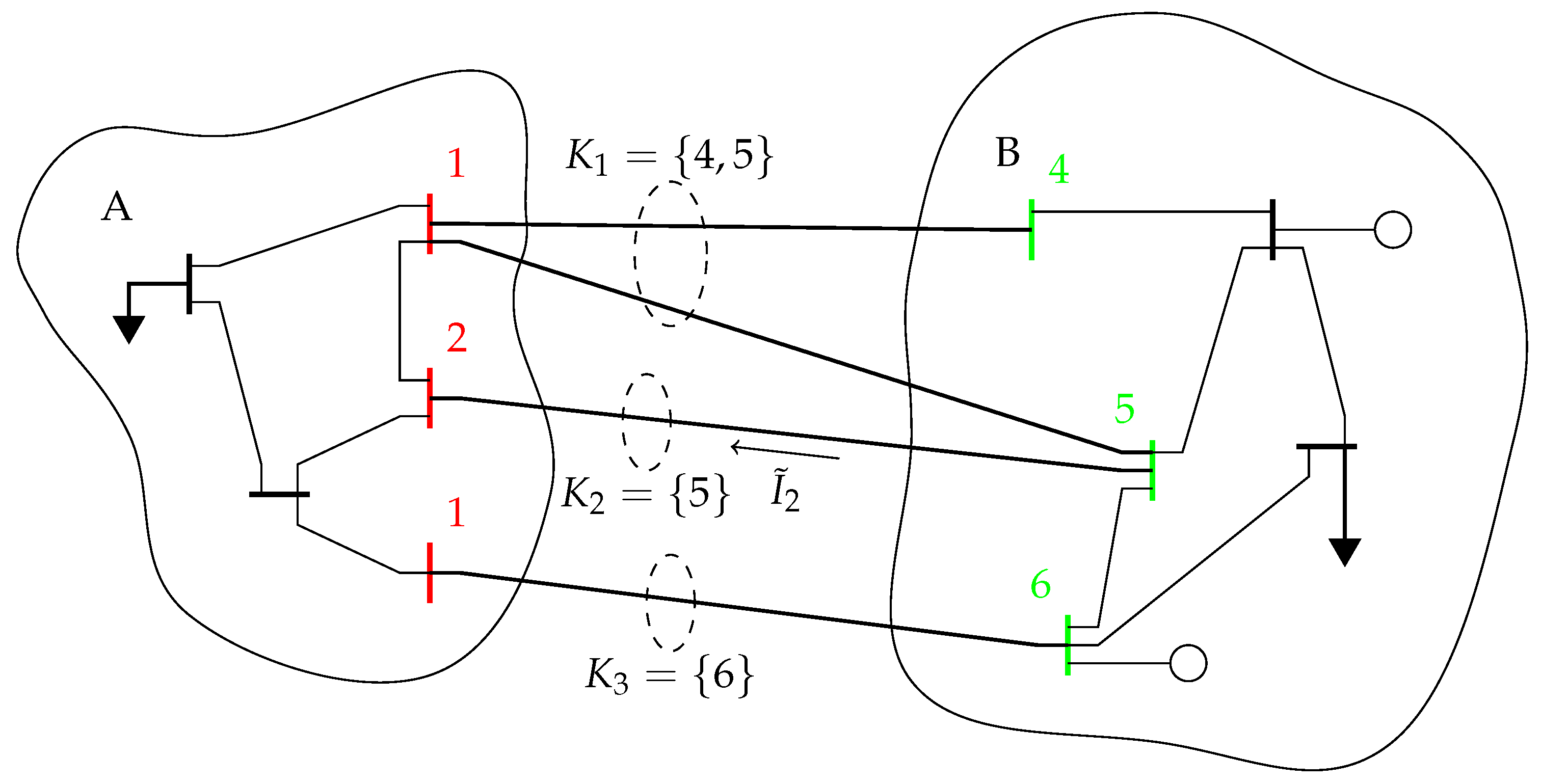


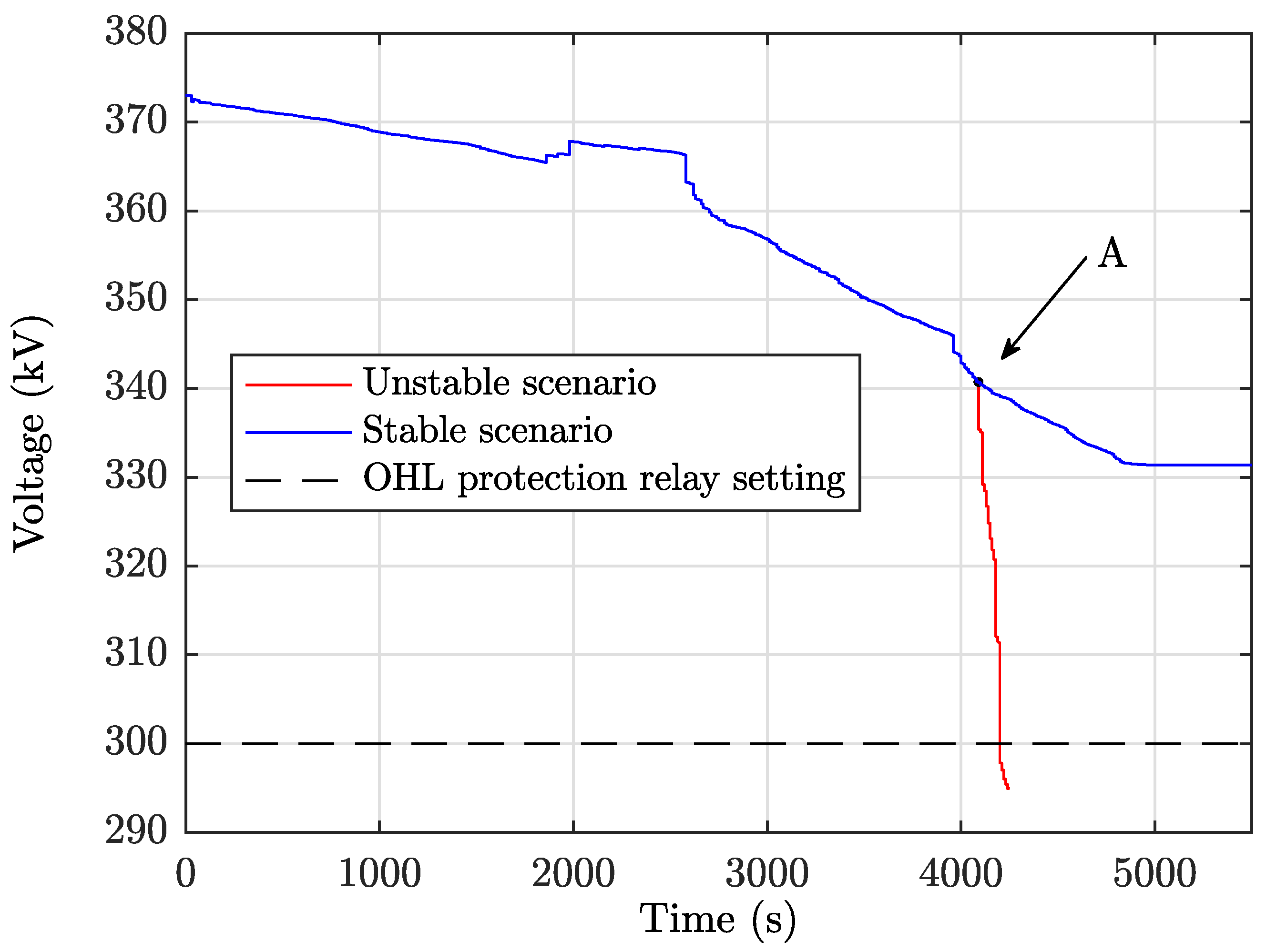
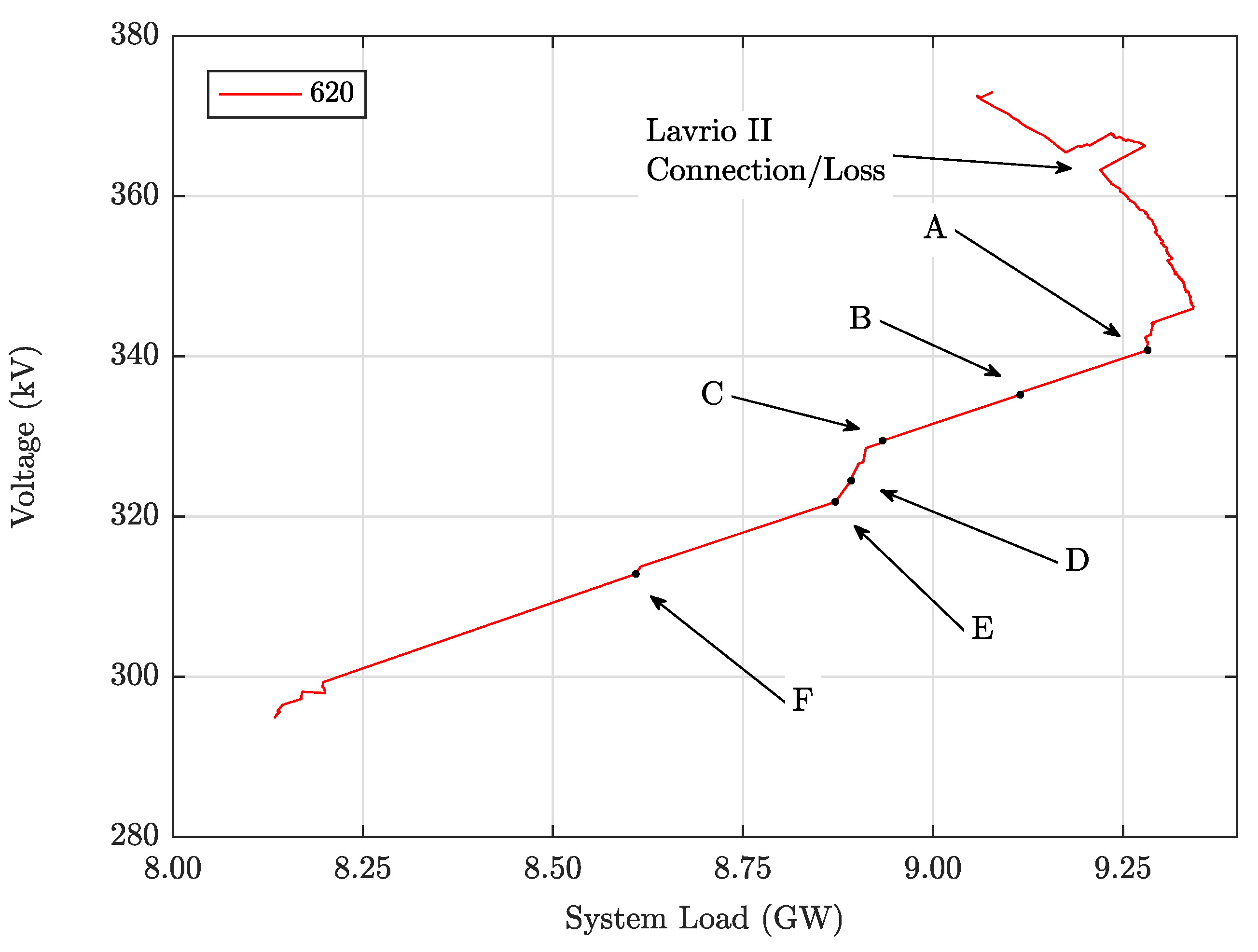


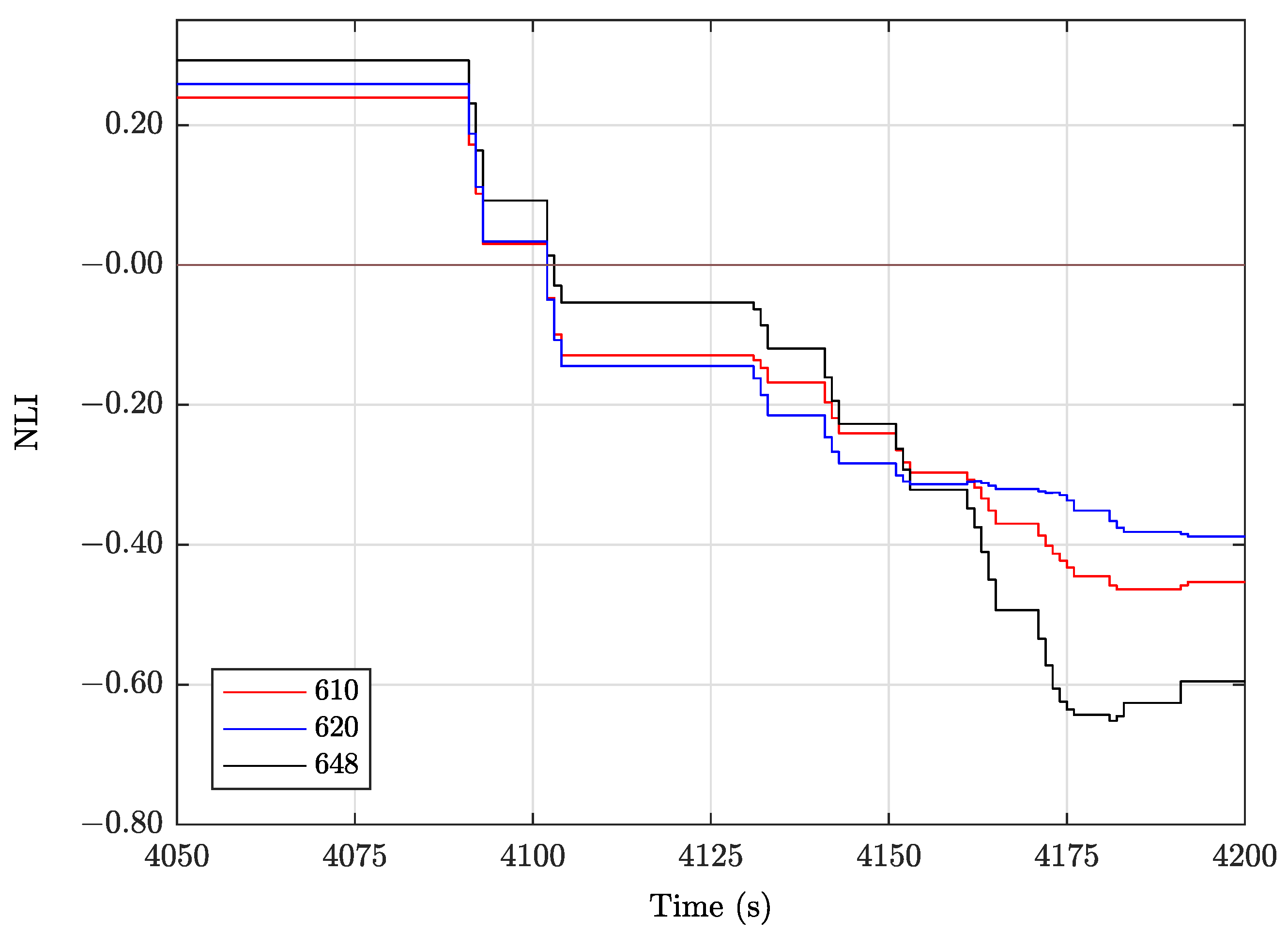

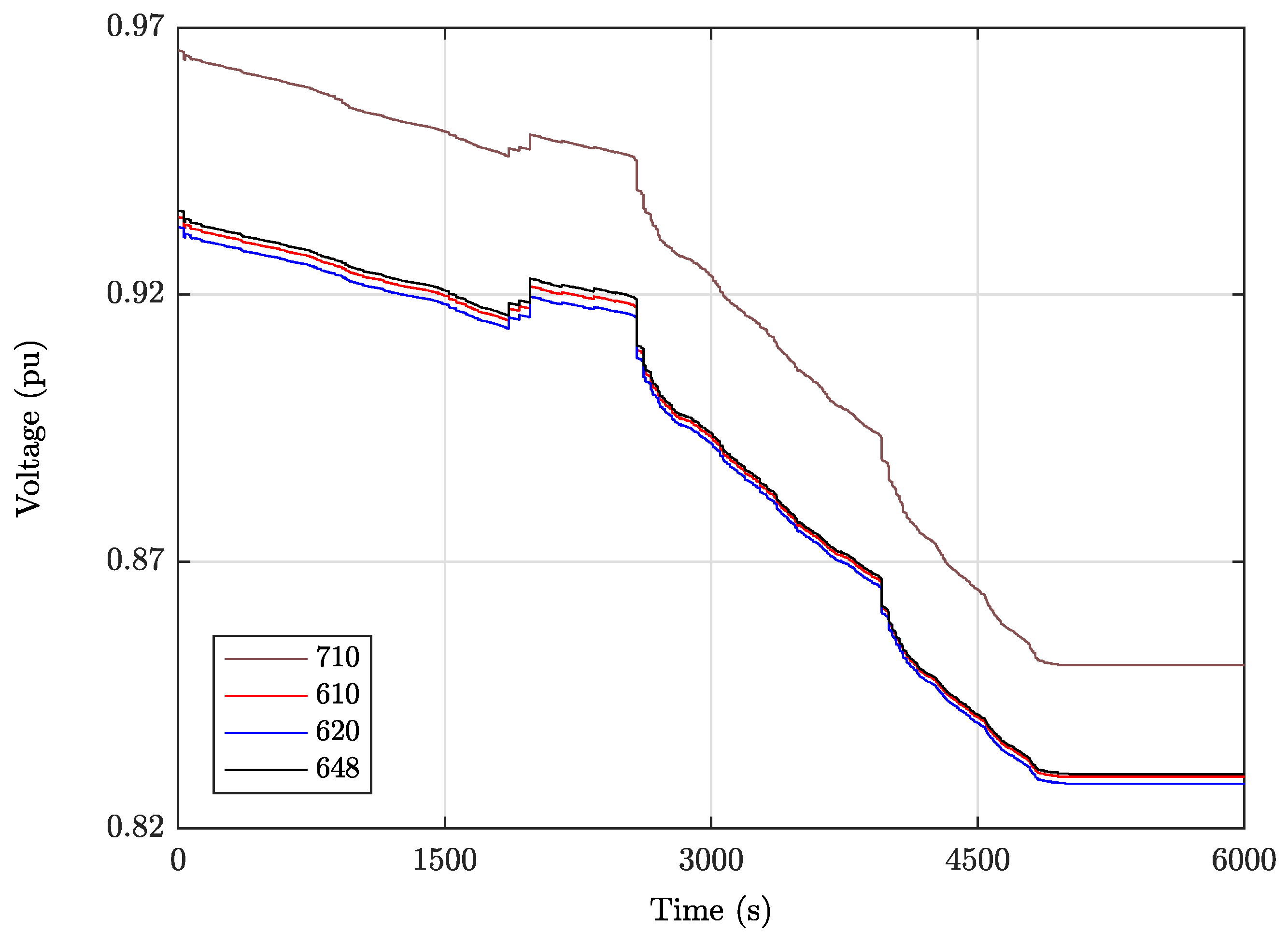



| Arrival Boundary Bus | Departure Boundary Bus |
|---|---|
| 620 (Koumoundourou) | 404 (Distomou) |
| 939 (Koumoundourou) | 404 (Distomou) |
| 610 (Acharnon) | 395 (Larymnas) |
| 1915 (Acharnon) | 395 (Larymnas) |
| 648 (Ag. Stefanou) | 395 (Larymnas) |
| 648 (Ag. Stefanou) | 395 (Larymnas) |
| t (s) | Unit | Bus | Event | Point in Figure 5 |
|---|---|---|---|---|
| 20 | Aliveri IV | 338 | OEL | |
| 30 | Lavrio 4 | 667 | OEL | |
| 60 | Aliveri III | 337 | OEL | |
| 1649 | Lavrio I | 664 | OEL | |
| 1860 | Lavrio II | 660 | Load pick up | |
| 2498 | Lavrio I | 664 | OEL | |
| 2580 | Lavrio II | 660 | Unit loss | |
| 2610 | Megalopoli III | 569 | OEL | |
| 2930 | Ag. Georgios 9 | 675 | OEL | |
| 3468 | Ag. Georgios 8 | 674 | OEL | |
| 4090 | Aliveri III | 337 | Disconnection | A |
| 4101 | Aliveri IV | 338 | UV trip | B |
| 4102 | 620 | Alarm | C | |
| 610 | ||||
| 4103 | 648 | |||
| 4120 | Megalopoli IV | 575 | OEL | |
| Ladonas II | 583 | OEL | ||
| 4150 | Ladonas I | 582 | OEL | |
| Stability limit | D | |||
| 4162 | Ag. Georgios 9 | 675 | UV trip | E |
| 4173 | Lavrio I | 664 | UV trip | F |
| Ag. Georgios 8 | 674 | UV trip | F | |
| 4200 | Megalopoli II | 573 | OEL | |
| 4233 | Megalopoli III | 569 | UV trip | |
| Collapse |
| t (s) | Unit | Bus | Event |
|---|---|---|---|
| 4166 | Ladonas II | 583 | OEL |
| 4190 | Megalopoli IV | 575 | OEL |
| 4449 | Ladonas I | 582 | OEL |
| 4800 | End of load increase | ||
| 5013 | Steady State | ||
| Substation | Bus | (MW) | (MVAr) | (MW) | (MVAr) |
|---|---|---|---|---|---|
| MEGARA | 709 | 14.8354 | 7.7040 | 7.418 | 3.852 |
| MEGARA | 950 | 14.31149 | 15.5524 | 7.157 | 7.776 |
| ELEFSINA | 687 | 36.1574 | 28.7276 | 18.079 | 14.364 |
| ELEFSINA | 688 | 39.0019 | 29.6629 | 19.501 | 14.831 |
| AEGALEO | 730 | 184.3492 | 67.7878 | 92.175 | 33.894 |
| AEGALEO | 953 | 75.0891 | 24.3724 | 37.545 | 12.186 |
| AEGALEO | 954 | 0.2977 | −2.2234 | 0.149 | 1.117 |
| Total | 364.0455 | 171.5735 | 182.023 | 85.787 | |
Publisher’s Note: MDPI stays neutral with regard to jurisdictional claims in published maps and institutional affiliations. |
© 2021 by the authors. Licensee MDPI, Basel, Switzerland. This article is an open access article distributed under the terms and conditions of the Creative Commons Attribution (CC BY) license (https://creativecommons.org/licenses/by/4.0/).
Share and Cite
Lambrou, C.; Mandoulidis, P.; Vournas, C. Validation of Voltage Instability Detection and Control Using a Real Power System Incident. Energies 2021, 14, 7165. https://doi.org/10.3390/en14217165
Lambrou C, Mandoulidis P, Vournas C. Validation of Voltage Instability Detection and Control Using a Real Power System Incident. Energies. 2021; 14(21):7165. https://doi.org/10.3390/en14217165
Chicago/Turabian StyleLambrou, Charalambos, Panagiotis Mandoulidis, and Costas Vournas. 2021. "Validation of Voltage Instability Detection and Control Using a Real Power System Incident" Energies 14, no. 21: 7165. https://doi.org/10.3390/en14217165
APA StyleLambrou, C., Mandoulidis, P., & Vournas, C. (2021). Validation of Voltage Instability Detection and Control Using a Real Power System Incident. Energies, 14(21), 7165. https://doi.org/10.3390/en14217165






